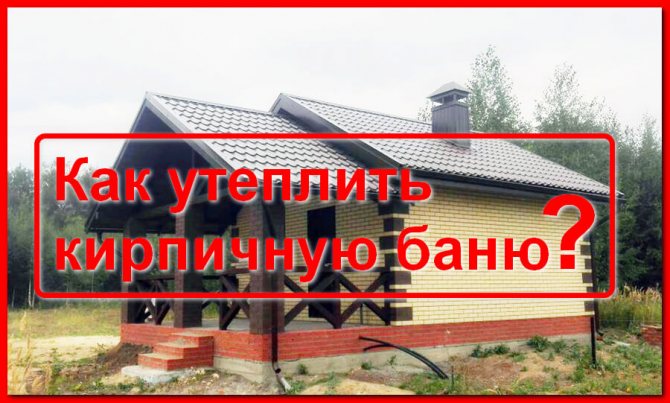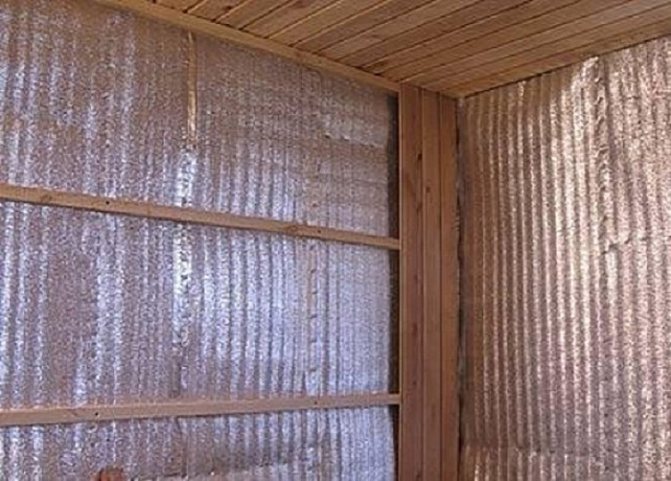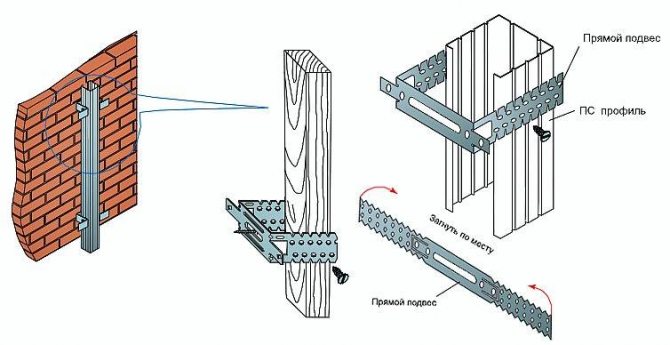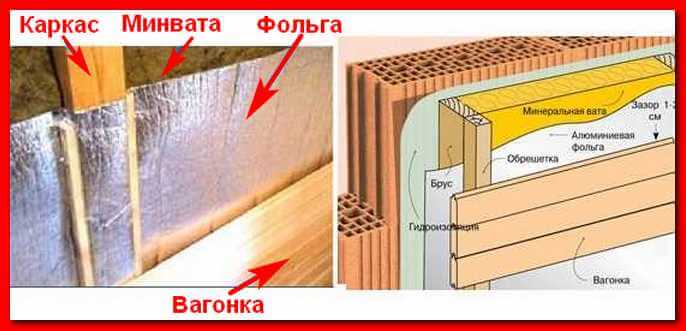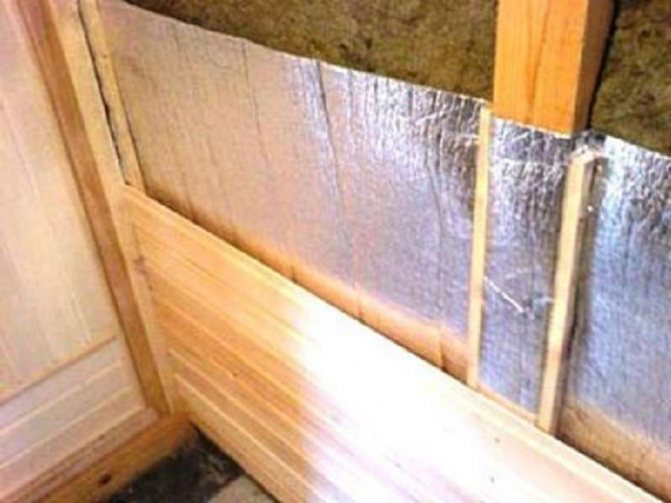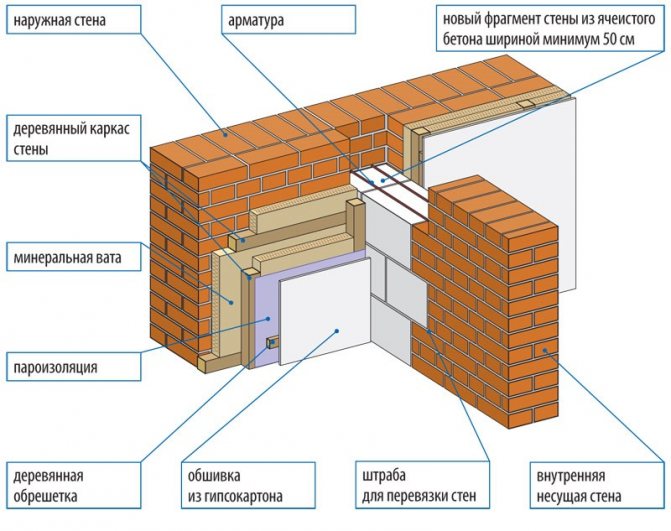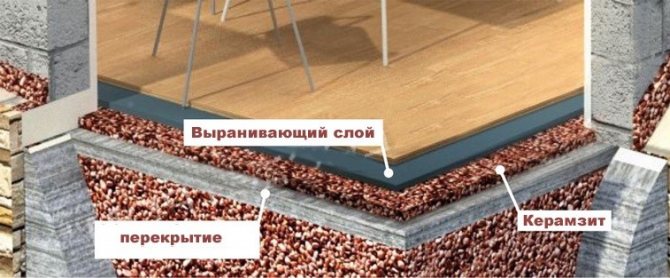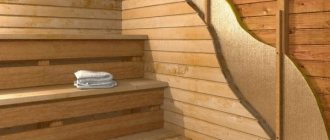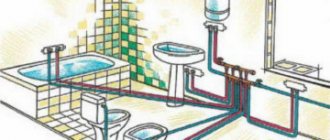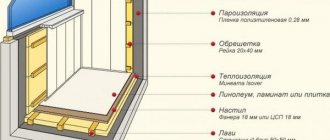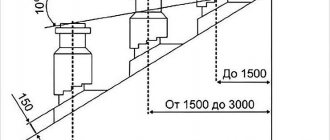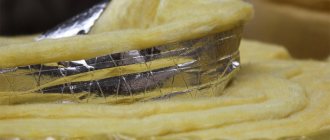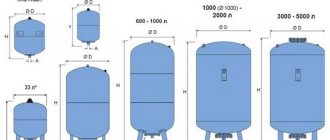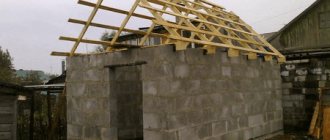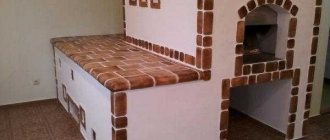How to insulate a wall in a brick bath

The decoration of the steam room should be carried out using heat insulators that do not emit substances harmful to the human body. For this, insulation materials that are not susceptible to moisture from fiberglass or basalt are suitable. Bath insulation should be comprehensive and include insulation of elements such as the floor, foundation, roof and walls. Let's consider in detail how to properly insulate, and what methods are used for each element.
Foundation
The concrete of which the foundation is made is a strong conductor of cold. Before erecting the wall, it is insulated with roofing material so that cold and moisture does not get from the ground. However, this is not enough. It is necessary to finish the walls of the foundation from the base in order to increase heat storage and minimize the subsidence of the foundation
This is important, since in winter the earth expands under the influence of cold, while cracks form in the foundation that destroy it. Of the materials, it is worth choosing penoplex, it is cheaper than polyurethane foam, but its installation takes longer
The second material is also quite good and can be collected in a day.
Bath floors
To protect the floor from ground moisture, an expanded clay pillow is required before installing the slabs. The thickness of its layer depends on the thickness of the walls, and should be twice as large. A basement is not needed for a bath, so expanded clay is filled completely over the entire inner surface of the foundation. The floor in the bath is preferably made of concrete slabs. It handles moisture better than wood.
Wall decoration
The insulation is fixed on a pre-fixed cobbled lathing, it will prevent the material from slipping, protect it from compression, while retaining its original properties. When choosing a heater, you should take into account what type is used: expanded clay, foam phone, isolon, or others. The scheme of insulation of bath walls:
- The masonry is done in several passes, the brick is periodically filled with a prepared lime solution.
- Insulation boards are located from the inside, between the load-bearing wall and the finish.
- A lining or wooden panels are attached on top of the insulation.
Roof trim
Complex insulation of a steam room in a brick bath cannot do without a ceiling. Steam primarily rises upwards, which is why the roof of the steam room is especially susceptible to high temperatures and high humidity. Therefore, he needs to be given no less attention than the walls. For the roof, experts in insulating the bath from the inside recommend using mineral wool with a double-sided waterproofing coating. Foil-clad fiberglass works well for these purposes. The use of expanded polystyrene is not recommended. At such temperatures, it releases substances hazardous to the body.
https://youtube.com/watch?v=wm1q_X5klK0
Major mistakes
Bearing walls made of bricks are distinguished by high thermal conductivity and heat capacity, acting on these properties as the complete opposite of log cabins.
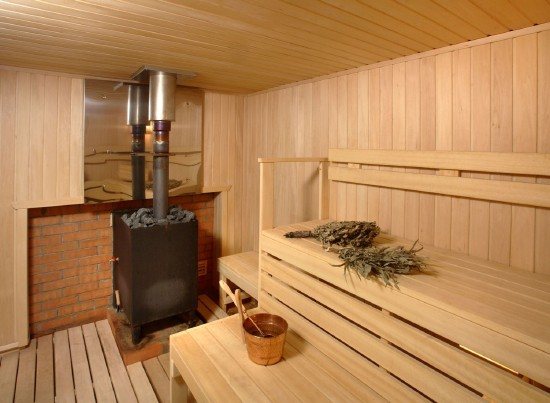

We carry out insulation of a brick bath from the inside, only at the stove we do not forget about fire safety
Unlike thermal insulation of residential premises, it makes no sense to insulate a bath from ceramic or silicate bricks outside. For buildings with periodic heating, the heat capacity plays a negative role, since it requires more time for heating. For this reason, the main thermal insulating layer in brick baths should be placed exclusively in the composition of the inner sandwich.
Mistake number 1.When erecting brick walls, the seam joints are not completely sealed, and as a result, a powerful cold bridge is created from all unfilled wall seams. Sometimes it almost completely negates the wall insulation.
Mistake No. 2. Facing boards are stuffed directly onto the insulation crate. This, firstly, violates the integrity of the vapor barrier layer. Secondly, there is no guaranteed gap between the skin and the reflective canvas. In both cases, this threatens moisture penetration, wetting of the insulation and the appearance of mold on the crate.
Mistake No. 3. The cladding material is attached with nails or screws with shallow heads, as a result of contact with them, you can get burned.
If, when insulating a brick bath, you follow the entire technology of this process and avoid the listed mistakes, then the procedures carried out in the bath will really be healing and strengthening your body.
Insulation of a brick bath from the inside
How to insulate the walls of a brick bath from the inside? It is most effective to insulate the inner surface of the walls of a brick bath with the help of natural heat-insulating materials that perfectly retain heat, but do not emit any harmful substances at high temperatures. In particular, sheets based on mineral wool, produced in the form of rolls or individual mats, are excellent for these purposes.
The only drawback of such a heater is the ability to absorb moisture, which, by definition, is always enough in any bath. Therefore, the heat-protective layer will require additional waterproofing, which protects the mineral wool from steam and water.
The procedure for installing insulation on internal walls will be as follows:
- a supporting frame is being erected on a brick wall from wooden slats;
- insulating material is laid in the resulting cells. In addition to mineral wool, more modern materials can be used here with great success. For example, foil-clad foam is not only completely insensitive to moisture and temperatures of several hundred degrees, but due to the shiny surface of the foil, it is able to reflect heat back into the bathhouse;
- the entire structure is covered with a layer of waterproofing (polyethylene, foil, etc. To ensure complete moisture resistance, the waterproofing material should be laid with an overlap of 10-20 cm. To give the joints additional strength, all joints should be fixed with thin and flat wooden slats.
In order to improve aesthetics, thermal insulation is usually not left open, but covered with wooden clapboard.
In addition to the walls, the internal thermal insulation of a brick bath should also include measures to reduce heat loss through the floors. The sequence of actions here will be as follows:
- a layer of vapor barrier is laid on the subfloor cleaned of dust and dirt;
- heat-insulating mats are lined and fixed in one way or another;
- a layer of waterproofing is laid;
- a finishing floor is equipped with the widest boards with a thickness of at least 40 mm.
It is very important to consider the material from which the sub-floor is made. If it is formed by boards, then they will need to be pre-treated with a means to prevent wood rotting .. A concrete subfloor itself is capable of playing the role of thermal insulation
Therefore, even at the stage of its arrangement, one should take care of imparting heat-saving properties. This is achieved by the following flooring technology:
The concrete subfloor itself is capable of playing the role of thermal insulation. Therefore, even at the stage of its arrangement, one should take care of imparting heat-saving properties. This is achieved by the following flooring technology:
- a layer of sand about 5-10 cm thick is poured into the pit;
- a solid heat insulator (foam) is laid;
- a mixture of cement, sand and crumbled foam is poured;
- sheets of roofing material are overlapped;
- reinforcing mesh is lined;
- a concrete solution is poured with the addition of fine crushed stone;
- a finishing plank floor is created at a height of 10-20 cm.
The resulting design is advantageous in that it is ventilated. This means a significant increase in the service life of both the finished floor and the heat-insulating concrete base underneath.
How to insulate the floor in a bath? You will find out the answer to this question by reading this article.
And in this article, read about the bath roof insulation.
Materials and tools
Now there is a large selection of heaters on the market and one must remember that bath procedures will bring a healing effect only when natural products are used inside the bath. In this case, the requirements for thermal insulation products are put forward as follows:
- Environmental friendliness of insulation. At elevated temperatures and high humidity, insulation can emit toxic substances. Therefore, before insulating a bath, this indicator must be taken very carefully;
- Hydroscopicity. The insulation should not get wet during operation;
- Thermal conductivity. The lower the coefficient of this material, the less heat this product passes through itself over a certain period of time;
- Biological inertness. There should be no impact of harmful impurities on the human body;
- Fire safety;
- The ability to maintain its shape;
- Low cost and easy installation.
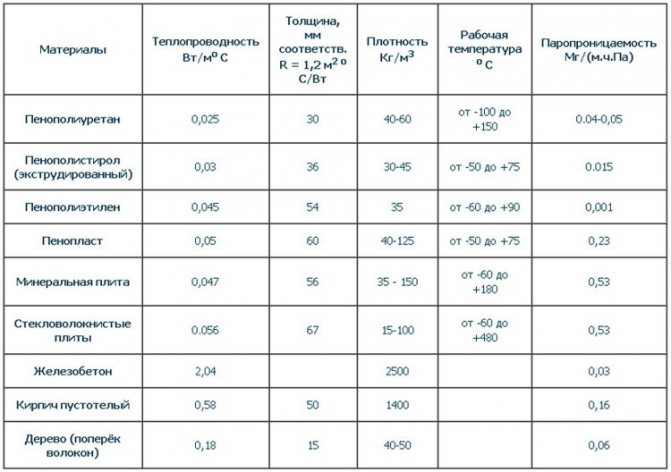

Comparison of heaters for different parameters
To understand which insulation is best suited for a bath, you need to know their parameters. Let's take a closer look.
For a long time, this material has been used to keep warm in a Russian bath. The indisputable advantage of this insulation is its naturalness and availability. But there are also many disadvantages:
- Fire hazard;
- High hydroscopicity;
- Difficulty in application;
- Rodent susceptibility.
In this regard, the use of organic insulation goes into oblivion and is used very rarely.
In these natural products, synthetic or adhesives are used during manufacture.
These include:
- Reed slabs;
- Chipboard;
- Peat slabs.
Such insulating materials may well be used to insulate the outside of the bath with additional protection from precipitation, but it is unacceptable to use them from the inside on the walls of the steam rooms.


These goods are manufactured in a production environment and are divided into two types:
- Polymers. Among them are polystyrene, expanded polystyrene.
- Polyurethane foam.
It is impossible to insulate the bath inside, especially in the steam room, with such material, since the foam at high temperatures emits a harmful substance - styrene. However, outside for thermal insulation of the building is an ideal option.
Penoizol. It is a foil-clad thermal insulation material used in the twin ward. It is an exception to the range of polymeric materials due to its reflective properties.


Foil insulation
Mineral wool. This group includes basalt wool and glass wool. Their advantage is fire safety and resistance to thermal insulation. The disadvantages include high hydroscopicity, which necessitates the use of films.
Basalt wool is an environmentally friendly material that is recommended for use in steam rooms and saunas. Having chosen a suitable insulation, you need to purchase related materials, as well as prepare a tool.
| Material | Application | Specifications |
| Basalt wool | Thermal insulation inside the bath | 100 mm (solid) |
| Vapor barrier film (penotherm) | Protection of insulating material from dampness | Heat resistant |
| Beams | For the frame | 50 × 50 mm |
| Planed board | Wall cladding | 100 × 20 mm |
| Reiki | For the frame | 30 × 25 mm |
If it is planned to make a concrete screed for the floor, then the list of materials will increase, including the following products:
- Reinforcement mesh;
- Composition for filling screed (sand, water, cement);
- Damper tape;
- Lighthouses.
For the external filling of the ceiling, you will need expanded clay and polyurethane powder.
Tool
From the tool you need to prepare:
- A circular saw;
- Perforator;
- Level;
- Hacksaw;
- Fasteners (nails, screws).


Insulation materials and tools
When installing the facing material, the heads of the nails and self-tapping screws must be deepened inside the boards in order to avoid burns from accidental contact during bathing procedures.
We will now learn how to insulate a bathhouse from the inside out of bricks. In our case, we will focus on such insulation materials as mineral wool for walls and ceilings, expanded clay for the floor and foamed polyethylene foam as a reflector. As additional material for study, you are invited to a video in this article.
Bath insulation
Installation of insulation
Mineral wool, expanded clay and foamed polystyrene foam
- Before describing the features of the installation of thermal insulation that we have chosen for work, we will consider some of the features of these materials. First, let's pay attention to mineral wool, which can be different and from all varieties it is better to use stone or glass wool. There is also slag, but due to the fact that it is made from melts of blast-furnace slag, it contains elements of iron ore that do not tolerate the prolonged presence of moisture.
- Expanded clay can be insulated not only on a concrete or wooden floor, but also on the ceiling, but this is only in those cases when the room is equipped with an attic. The fraction of the material is different - less than 5 mm (expanded clay sand), 5-10 mm (fine), 10-20 mm (medium) and 20-40 mm (large). Such insulation is porous and light, its weight ranges from 350 to 600 kg / m3, depending on the density and size of the granules. Another important advantage is its price, which, on average, is much lower than all other materials.
- The design and composition of foamed polyethylene foam is indicated by its name, and its use in a steam bath looks like a bonus to the foil, since you can do without a layer of polyethylene foam - mineral wool covered with foil will be enough. But, nevertheless, this enhances the power of thermal insulation, so we stopped at this option and choose the thinnest of all - 2-3 mm will be enough, although it can be up to 20 mm thick.
We suggest that you familiarize yourself with: Headache after the bath
Ceiling insulation
With poor-quality thermal insulation, up to a quarter of all the heat generated by the furnace can go through the ceiling
Therefore, to reduce losses, ceiling insulation should be given no less attention than in the case of walls. The most suitable insulating material for these purposes is lightweight and non-combustible fiberglass
Ceiling insulation works in the bath are carried out as follows:
- canvases or mats made of fiberglass are laid out on the boards of the ceiling;
- a mixture of equal parts of sawdust, sand and clay is poured over it. The optimum thickness of this layer is 20-25 cm;
- after the previous layer has dried, sheets of foam are laid out on it;
- the entire surface is filled with a small layer of cement screed.
In addition, ordinary expanded clay can provide excellent thermal insulation. With a backfill thickness of about 30-40 cm, it will be able to reliably retain precious heat.
Thermal insulation of a bath from foam blocks. Read about it here.
And this article talks about the insulation of a wooden bath.
Here https://ru-house.net/stroitelstvo/ you will find many more informative articles about building a house.
Thermal insulation of the walls of the bath process features
When you have completed the process of floor insulation, we begin wall insulation from the inside.
Please note that you do not need to loosen or process a brick tub from the inside of the bathhouse, since this wall surface will later disappear behind the wood sheathing for the steam room
The only thing that needs to be done is to saturate the brick wall in order to protect it from bacteria, but this procedure is relevant only for rooms such as steam rooms and shower rooms.
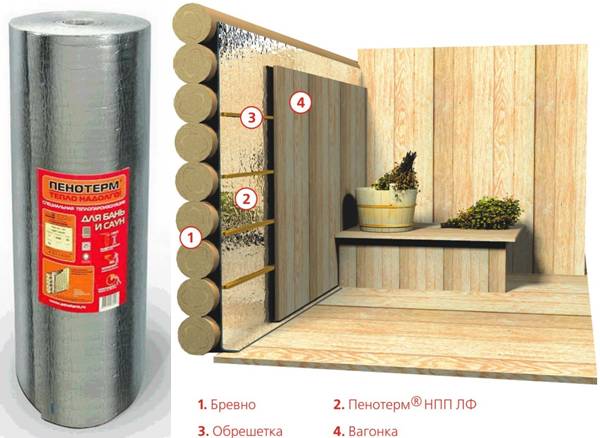

The walls of the baths should be insulated in exactly the same way as other rooms, and not only baths. However, there are a number of process features that are unique to this type of work:
- to reduce the number of possible heat losses, close the gaps between the wall and the windows using polyurethane foam; the frame for mounting the cladding must be made of wooden beams, then attach it directly to the brick tub; it is highly undesirable to use suspensions and metal profiles for work, since they have the property conduct heat; insulation in the form of mineral wool or polystyrene plates is placed in the crate cells: the insulation is attached to the tub with dowel-umbrellas or with a special adhesive; if you are going to glue the heat insulator, then it is better to treat the brick wall of the bath with a penetrating primer before that.
So, when the main insulation has already been applied to the walls, it is necessary to apply a layer of vapor barrier, which you can use kraft paper, glassine or foil film, which, by the way, will be the most optimal material for the steam room and shower room. For example, the same kraft paper, when used in places of high humidity, can become soaked over time and become unusable.
If necessary, fill the counter battens on the battens of the sheathing. This will create a gap between the outer skin and the vapor barrier. Then, the lining should be attached to the counter-batten using thin wooden strips.


When your bath or sauna has a large area and occupies several floors, it is not necessary to insulate the walls from the inside everywhere in order to prevent strong heat losses during its operation. If a loggia is attached to the bath, it must also be insulated. You should also install good entrance doors equipped with at least two sealing circuits.
Wall sandwich scheme
You can find recommendations for warming brick baths with the help of internal masonry made of wooden beams with a section of 100 × 100 mm, on top of which a layer of mineral wool is mounted. This begs the question: why bother with brick at all, if the first layer of such insulation is a sufficiently strong wall for a one-story building? This scheme is not feasible from an economic point of view.
Brick bath insulation scheme
- decorative interior decoration (lining, tongue-and-groove boards, etc.);
- gap 1 - 2 cm;
- folgoizol, oriented with the reflective side inward;
- mineral wool (slabs or roll material 10 cm thick);
- waterproofing membrane.
It is easy to insulate a brick bath from the inside with your own hands without the involvement of specialists. To do this, it is quite enough to confidently own a drill, stapler, hacksaw and screwdriver, as well as to have a sufficient amount of free time. First, a membrane is attached to the load-bearing wall. Then a vertical lathing is mounted, with a thickness equal to the insulating layer or exceeding it by 1 - 2 cm.
Cotton wool is laid inside the crate, after which the foil-insol is attached to the bars with a stapler. Better to overlap the stripes. The joints of the foil-clad material are insulated with special tape. On top of the infrared screen, a horizontal rail is stuffed, which serves as a support for the finishing and a base for the formation of an air gap.
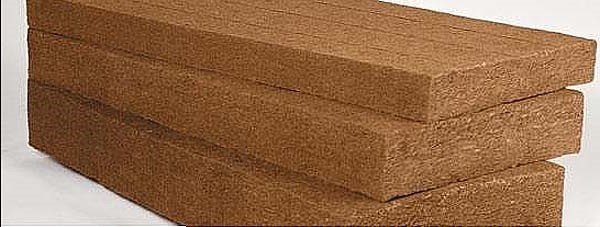

Expanded polystyrene can be used as the main heat-insulating layer, subject to two conditions:
- As an infrared screen, a material is used that has an inner surface of polyethylene foam with a thickness of at least 1 cm.
- An air gap of at least 2 cm must be maintained between the screen surface and the expanded polystyrene plates.
Due to these measures, penoplex or polystyrene does not heat up to the permissible limit of 75 ° C, even if the temperature in the steam room reaches temperatures above 90 ° C. The boards are glued to the inner surface of the brick wall, and the waterproofing membrane is excluded from the sandwich.
Insulation outside
Before starting to insulate a brick bath from the outside, it is necessary to carefully analyze the issue of laying bricks:
- The mortar should fill all the space between the bricks evenly, at the same thickness; The first row of brickwork should be made only of solid elements; The beams rest on the butt row; As for clay bricks, before laying them, it is necessary to thoroughly moisten the brick, especially, if the bath is arranged in the summer season.
In order to insulate the bath from the outside of the building, it is necessary to lay expanded clay between the walls with a thickness of 40-50 centimeters. You can also use slag, fluff of lime, sawdust and sand for this.


But it will be more rational to insulate the walls of the bath from the outside with a slab insulation. Direct fixation of the insulation layers occurs with the help of a synthetic binder. Plates are placed in spacers at a distance of half a meter from each of the plates. Read the instructions on how to choose a stove for a bath.
It is worth installing the slab insulation so that small gaps remain between the elements. They are necessary for ventilation of the facade, because otherwise, the entire surface will be covered with mold during the rainy season.

